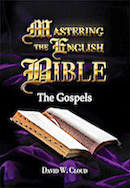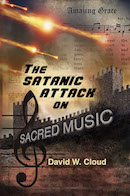866-295-4143, fbns@wayoflife.org
The following is excerpted from The Way of Life Commentary Series: Joshua-Chronicles.
_________
Nebuchadnezzar gathered his armies against Jerusalem for the third time.
● For map, see The New Moody Atlas of the Bible, “Jerusalem Falls to Babylon,” map 80.
- The siege and destruction of Jerusalem by Nebuchadnezzar was a major event in the history of God’s program, so it receives a lot of attention in God’s Word. Compare 2 Kings 25; 2 Chronicles 36; Jeremiah 39 and 52; Ezekiel 4.
- This was the final punishment for Israel’s longstanding wickedness and hardness of heart and rejection of the prophets (Jer. 7:13-15).
- The destruction of Jerusalem in 586 BC is a powerful object lesson of the following things: (1) God’s Word is absolutely true, and every word will be fulfilled. God said, “I will bring my words upon this city” (Jer. 39:16), and that is exactly what happened. (2) God’s judgment on impenitent sin is certain. “God's judgment may be slow in coming, but it is as sure as it is slow” (Biblical Illustrator). (3) God is longsuffering in calling men to repentance. How long He rose up early and spoke to Israel by the prophets! (4) God protects His saints during evil times (e.g., his deliverance of Jeremiah, Baruch, Ebedmelech, the Rechabites, and others). About this same time, the prophet Ezekiel in Babylon saw a vision of God putting a mark upon the true believers in Jerusalem so they would be protected during the slaughter (Eze. 9:1-4).
- Nebuchadnezzar besieged the city for 18 months, from the ninth year and tenth month of Zedekiah, until the eleventh year and the fourth month (2 Ki. 25:1-3; Jer. 39:1-2; 52:4-6).
- Jerusalem was surrounded by a massive army. There were cavalry and chariots and wagons and soldiers. See Jer. 4:13; Eze. 23:24. Nebuchadnezzar’s army consisted of an alliance. There were Assyrians and Arameans (Eze. 23:23). “Perhaps Pekod, Shoa, and Koa were three Aramean tribes near the mouth of the Tigris River” (Bible Knowledge Commentary).
- God gave Ezekiel a preview of the siege (Eze. 4:1-17). This prophecy was given a few years before the final siege of Jerusalem. Read Eze. 4:1-3. The Babylonians built forts for their armies. Compare Jer. 52:4. This is what the Romans did centuries later. The forts were for the purpose of protecting the besieging armies from any sudden attack by the besieged or from an army that might come from some other place. The Babylonians built mounds to bring their battering rams up to the gates (“cast a mount against it,” Eze. 4:2). Compare Eze. 21:22. The mound constructed in the siege of Lachish required 25,000 tons of earth and rock, and it would have taken 1,000 porters 25 days to complete (Illustrated Bible Backgrounds Commentary of the Old Testament). The rams would have been similar to those used by the Assyrians. They were depicted in the artwork that decorated the Assyrian palaces and some of these depictions are in the British Museum’s Lachish Room. For pictorial accounts of battering rams and ancient siege tactics see Bible Times & Ancient Kingdoms, PowerPoint # 14 “Assyria” and PowerPoint # 18 “Rome’s Destruction of Israel.”
- In Lamentations, Jeremiah, an eyewitness, describes the siege. Toward the end of the siege, the people were starved. Jeremiah describes the horror of it. Elderly people died of starvation (La. 1:19). The people gave their most valuable things for food (La. 1:11). The children fainted in the streets for lack of food (La. 2:11-12). The rich dug through dunghills and trash heaps in search of food (La. 4:5). The people were reduced to skin and bones (La. 4:8). The pain of hunger was so great that death was preferred (La. 4:9). Some ate their own children (La. 4:10).
- The Babylonians finally made a break in the city walls (Jer. 39:2-4). The princes aligned with Nebuchadnezzar sat in thrones in the middle gate. This was probably in the north part of the city. The main assault of Jerusalem has always been from the north side, which is the most accessible. The other sides were protected by valleys. Nergalsharezer (also called Neriglissar) was Nebuchadnezzar’s son-in-law and he took the throne of Babylon upon the death of Nebuchadnezzar’s son, Evilmerodach.
- Zedekiah fled with some of his men of war (Jer. 39:4). He left the city by the way of the king’s garden below the pool of Siloam (Ne. 3:15), where the Kidron and Hinnom valleys meet, crossed the Mount of Olives, and fled west toward the way of the plain, referring to the plain of Jordan. It appears he was trying to escape to Ammon or Moab where other Jews had found safety. Compare Jer. 40:11. Probably the attention of the Babylonians was temporarily focused on the action in the north part of the city, allowing Zedekiah to escape.
- Zedekiah made it as far as the plain of Jordan near Jericho but was captured by the pursuing Babylonians before he could cross the river (Jer. 39:5-7). God had pronounced judgment on him for his sin and there was no possibility of avoiding it. He was taken to Riblah where Nebuchadnezzar maintained his military headquarters. This was in the north in Syria on the Orontes River about 65 miles north of Damascus. Nebuchadnezzar made his headquarters here during his campaign against Jerusalem (2 Ki. 25:6, 20-21; Jer. 39:5-6; 52:9-10, 26-27). Pharaoh Necho had put Jehoahaz in bands at Riblah (2 Ki. 23:33). See “Jehoahaz of Judah.”
- Nebuchadnezzar had Zedekiah’s sons killed and his eyes put out, and he was carried to Babylon in chains in shame and degradation (Jer. 39:7). Ezekiel had prophesied that Zedekiah would be taken to Babylon but he would not see it (Eze. 12:13).
Nebuchadnezzar destroyed the city in 586 BC (2 Ki. 25:4-17).
- The king’s palace was burned. This was the glorious palace built by Solomon of rare cedar of Lebanon and the best cut stone (1 Ki. 7:1-12).
- All of the palaces and wealthy houses were destroyed (La. 2:5). Compare Jer. 52:13.
- The walls and gates of the city were torn down (La. 2:8-9). Compare Jer. 52:14.
- The elders of the people sat in silence, clothed in sackcloth, with dust on their heads, their heads drooping to the ground (La. 2:10).
- The streets were filled with the dead (La. 2:21).
- The stones of the temple were strewn about in the streets (La. 4:1).
- Women were raped, princes were tortured, and children and young men were made slaves to perform common labor (La. 5:11-13).
- Nebuchadnezzar killed the chief priest and other officials at Riblah (2 Ki. 25:18-21).
- The people were robbed of all their pleasant things (La. 1:10).
● For a map, see The New Moody Atlas of the Bible, “Jewish Deportations and Returns,” map 81.
The Jewish survivors were taken captive to Babylon, except for the poorest, who were left to care for the land (Jer. 39:9-10).
- Zephaniah said God would search Jerusalem with candles to punish the sinners (Zep. 1:12). To search with candles describes a diligent search, a search of every “nook and cranny.” The metaphor of God searching everywhere with candles should be a frightful thought to the unrepentant sinner. It is impossible to hide from God.
- Habakkuk said they would gather the captivity as the sand (Hab. 1:9). Multitudes of Jews were taken captive and sold as slaves by the Babylonians. See 2 Ki. 24:14-16; 25:10-11. This was the second event of Israel’s worldwide diaspora. The first was when the Assyrians took northern Israel captive and transported multitudes of them to Mesopotamia. The third event was when Rome destroyed the second temple in AD 70, and the fourth was when the Romans defeated the Bar Kokhba revolt and evicted the Jews from the land in AD 135.
- Receive these reports by email
- www.wayoflife.org
______________________
Sharing Policy: Much of our material is available for free, such as the hundreds of articles at the Way of Life web site. Other items we sell to help fund our expensive literature and foreign church planting ministries. Way of Life's content falls into two categories: sharable and non-sharable. Things that we encourage you to share include the audio sermons, O Timothy magazine, FBIS articles, and the free eVideos and free eBooks. You are welcome to make copies of these at your own expense and share them with friends and family. You may also post parts of reports and/or entire reports to websites, blogs, etc as long as you give proper credit (citation). A link to the original report is very much appreciated as the reports are frequently updated and/or expanded. Things we do not want copied and distributed are "Store" items like the Fundamental Baptist Digital Library, print editions of our books, electronic editions of the books that we sell, the videos that we sell, etc. The items have taken years to produce at enormous expense in time and money, and we use the income from sales to help fund the ministry. We trust that your Christian honesty will preserve the integrity of this policy. "For the scripture saith, Thou shalt not muzzle the ox that treadeth out the corn. And, The labourer is worthy of his reward" (1 Timothy 5:18). Questions? support@wayoflife.org
Goal:Distributed by Way of Life Literature Inc., the Fundamental Baptist Information Service is an e-mail posting for Bible-believing Christians. Established in 1974, Way of Life Literature is a fundamental Baptist preaching and publishing ministry based in Bethel Baptist Church, London, Ontario, of which Wilbert Unger is the founding Pastor. Brother Cloud lives in South Asia where he has been a church planting missionary since 1979. Our primary goal with the FBIS is to provide material to assist preachers in the edification and protection of the churches.
Offering: Offerings are welcome if you care to make one. If you have been helped and/or blessed by our material offerings can be mailed or made online with with Visa, Mastercard, Discover, or Paypal. For information see: www.wayoflife.org/about/makeanoffering.html.





